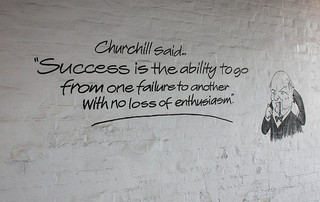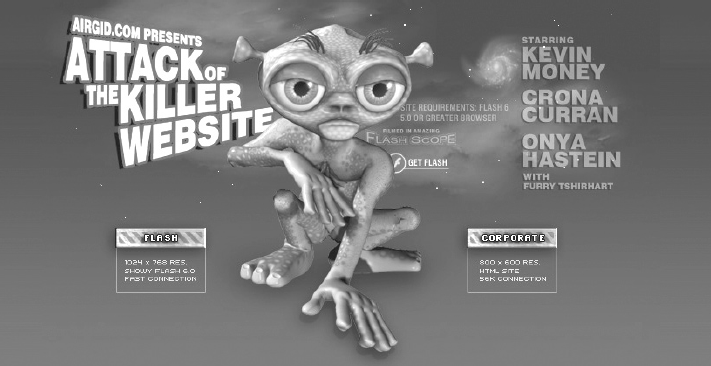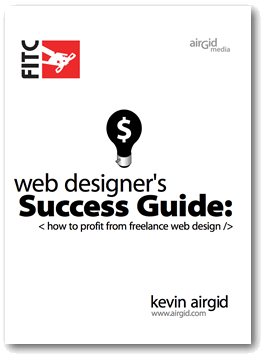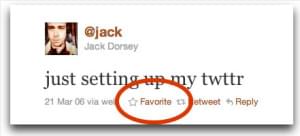Following on from my last review of Steve Krug’s excellent Don’t Make Me Think, today I’m going to be taking a look at Kevin Airgid’s Web Designer’s Success Guide: how to profit from freelance web design.
This is another book that both rookie and experienced designers alike should be giving at least a once over. Even if you’re not thinking of taking the plunge into the scary world of self-employment just yet, this book contains great advice to prepare you should you ever decide to go freelance.
The book opens with a sensible discussion on whether you’re really ready to become a freelancer. Here, Kevin gives advice based on his own experience (as everything in the book is, really) and describes the two prominent reasons why any designer may decide to go freelance: fun or fear.
The gist of what he’s saying here is that many designers tend to begin doing a little work on the side for the fun of it and it develops from there.

The fear factor, on the other hand, is when you’ve been forced into a situation such as redundancy which means that you have to do something to make some money.
The great part about this is that he pulls no punches and sets out the realism of the situation. Which is, if you jump in with both feet, then you’re very likely to get a very nasty shock when it comes to (not) making any money.
It is much better for both your mental health and your bank balance if you build up a small base of clients first, he says.
As well as this, Kevin advises that you also either save enough cash to get you through the first three months, or establish a line of credit. This kind of advice is invaluable.
For those that have never been in business before, it’s a harsh reality – which can be very depressing – to discover that actually, nobody is making enquiries and you’re not making any money.
Getting Down to Business
Moving on, the first chapter deals with the nuts and bolts of starting the business, looking firstly at the website that’s going to bring business in. Designers often create their own sites in their own tastes and don’t really consider how the client might consider it.

Kevin’s own first website for his business (above) was very much like this.
Whilst it received so much attention that he had to upgrade its hosting, it didn’t receive so much as one enquiry from a prospective client. This was due to its download time and the fact that you had to make four clicks in order to actually access the relevant information.

His second attempt (above) was much lighter and had a much more corporate feel and of course, worked much better in terms of attracting clients. This is invaluable advice; whilst it’s tempting to be smart and create a site that allows your creative side to really let loose, when it comes to business, it’s not the best step.
Tootin’ Your Horn
Chapter two is concerned with self-promotion and this is something that perhaps a lot of designers and creative types in general have an issue with (I know I have in the past!)

The ability to ‘brag’ about yourself, your talents and your work doesn’t come naturally to many of us, but it is essential if you’re in business and want to attract new clients.
Let’s face it, they won’t do it for you and it’s unlikely that they will think your shaky self-confidence as a brand new freelancer is cute. It’s up to you to ensure that you self-promote and do it well.
Another great piece of advice from this chapter was to Google yourself. Especially for those of us that have been living on the web for many years, there could be something lurking online that you’ve said in the past that you may regret now. It should be found and preferably done away with if that’s the case.
If this isn’t possible – well, forewarned is forearmed right?
Actionable Advice
As well as the above, there’s actionable advice aplenty in this and previous chapters and the ones that follow. From finding the right people to target in an email campaign, to free advertising opportunities, Kevin really does ensure that the book has real value when it comes to setting up your own business as a freelancer.
He looks into setting up your office, what hardware and software you should be looking at (whilst some of this may be out of date now, it’s relevant if you can apply what was available in 2006 to now) and even ‘the disillusionment’ you can feel.
With regard to the latter, it’s unlikely as a new freelancer that you’ll have the means to rent an office, or even equip your home office with awesome furnishings. Whilst it may get you down to think your office isn’t going to be the next Google, it’s back to realism with Kevin, who says no clients are going to actually see it, so don’t bother spending cash you don’t have kitting it out.
When Good Jobs Go Bad

Kevin even gives useful advice based again on his own experience on what to do when things go wrong. Whilst it would be nice to think that as a freelancer there will never be any issues and every client will be happy, it’s really only in designer heaven that this happens.
Things can and do go wrong and as the boss, it’s you that’s going to have to man up and deal with it, even when all you feel like doing is hiding under your desk until it all goes away.
Kevin describes in detail the mistakes he’s made, how he learned from them and even when he fired a bad client (something else to learn is that sometimes, there are bad clients that it’s just not worth dealing with).
This section is very useful and a great illustration of just how difficult it can be when you work for yourself.
Sharing the Love
Chapter five is concerned with how to share your knowledge in order to make an additional stream of income. This is advice that’s very relevant to today’s landscape as there’s a huge opportunity in the form of websites that will pay for you to do so.
Kevin lists, the following as potential income boosts:
- Books
- Speaking engagements
- Blogging
Again, all of this is accompanied by tips on how to get gigs, what to speak/write about and for the blogging section, even a reasonably in-depth explanation on how to install and set up WordPress. This is slightly out-of-date now that most hosts offer one-click installs directly from cPanel, but useful all the same.
The White Elephant in the Room

Chapter six looks into that thing that I guarantee has every new freelancer alternatively scratching their head and pulling out their hair – pricing. It’s so difficult when you start out to know how much to charge.
The web’s no help either and as rightfully Kevin points out, you should take everything you discover online about pricing with a large “grain of salt”.
He discusses the fixed rate versus hourly charge models, which have worked best for him and how to effectively manage each project.
In chapter seven, we move on to content management systems and the value of teaching clients how to update their own sites. These days it is of course much easier since WordPress has risen in popularity and has been adopted by so many sites. It’s so easy to use that most people can pick up how to put up a blog post quickly. This is possibly the least relevant chapter due to this as it does go into how to set up contributors to a site using various software.
Conclusion
This is a great book that gives actionable and useful advice for setting up as a freelancer. For me, the best thing is that it’s completely realistic and doesn’t sugar coat it – being in business can be highly stressful and a big risk.
However, for those who do still want to take the plunge, the book is packed with tips to help you to start and grow a sustainable business.
Kerry is a prolific technology writer, covering a range of subjects from design & development, SEO & social, to corporate tech & gadgets. Co-author of SitePoint’s Jump Start HTML5, Kerry also heads up digital content agency markITwrite and is an all-round geek.



